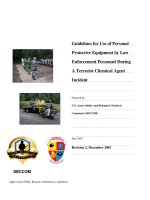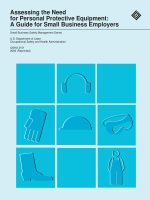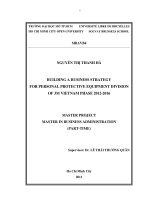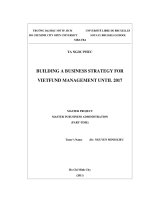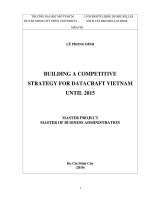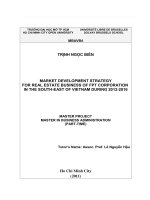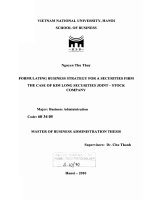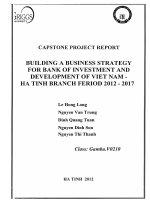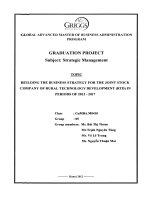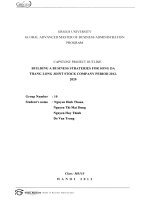Building a business strategy for personal protective equipment division of 3M Vietnam phase 2012 to 2016
Bạn đang xem bản rút gọn của tài liệu. Xem và tải ngay bản đầy đủ của tài liệu tại đây (3.38 MB, 92 trang )
i
TRƯỜNG ĐẠI HỌC MỞ TP.HCM UNIVERSITÉ LIBRE DE BRUXELLES
HO CHI MINH CITY OPEN UNIVERSITY SOLVAY BRUSSELS SCHOOL
MBAVB4
NGUYỄN THỊ THANH HÀ
BUILDING A BUSINESS STRATEGY
FOR PERSONAL PROTECTIVE EQUIPMENT DIVISION
OF 3M VIETNAM PHASE 2012-2016
MASTER PROJECT
MASTER IN BUSINESS ADMINISTRATION
(PART-TIME)
Supervisor: Dr. LÊ THÁI THƯỜNG QUÂN
Ho Chi Minh City
2011
i
COMMITMENT
It is to confirm that I hereby, Nguyen Thi Thanh Ha conducted this final project of the
MBA program with the acknowledgement of my professional supervisor and the
management of 3M Vietnam. This is entirely my own work and any use of the
materials extracted from books, articles, research papers, 3M’s data as well as other
sources is indicated in the reference sources.
I am confident to submit this project to the professors of the MBA program
Ho Chi Minh City, March 2012
Nguyen Thi Thanh Ha
ii
ACKNOWLEDGEMENT
I would like to express my sincere thanks to the professors of Solvay Business School
for their lectures with useful knowledge and practical experience that I gained in the
entire MBA course, to the program coordinator who provide much support and
assistance from the beginning course till the accomplishment time.
My deepest gratefulness goes to professional supervisor, Dr. Le Thai Thuong Quan for
his valuable and practical advice that helps me complete the thesis.
I acknowledge Mr. Parameswaran Nair - Managing Director, Leader team and
colleagues of 3M Vietnam for conveniences and conditions they gave me to write this
thesis.
I am also thankful to my friends for the best sharing and support during my study.
Last but not least, I would like to convey my lovely thanks to my husband for his
support and great encouragement during the past two years of my study so that I can
well complete the MBA course today.
With my best regards,
Ho Chi Minh City, March 2012
Nguyen Thi Thanh Ha
iii
COMMENTS OF SUPERVISOR
The topic has practical meaning and the author has successfully shown the ability to
build a strategy for market development. The results are based on the analysis of the
industry structure and the customer survey. Therefore, the solution is persuasive. In
overall, the presentation is clear and the thesis is up to the standard. I approve for the
public presentation
Ho Chi Minh City, March 15
th
2012
Le Thai Thuong Quan
iv
TABLE OF CONTENTS
COMMITMENT i
ACKNOWLEDGEMENT ii
COMMENTS OF SUPERVISOR iii
TABLE OF CONTENTS iv
LIST OF FIGURES vii
LIST OF TABLES vii
LIST OF ABBREVIATIONS viii
ABSTRACT ix
INTRODUCTION TO THE STUDY 1
1. Rationale of the study 1
2. Problem statement 1
3. Research objectives and questions 2
4. Scope and Limitation of study: 3
5. Methodology and Framework of Research Study 3
6. The structure of study 4
1.1 Definition of Strategy 1
1.2 Stage of Strategic Management 1
1.2.1 Strategy Formulation 2
1.2.1.1 Mission and vision 2
1.2.1.2 External Analysis 3
1.2.1.3 Internal Environment Analysis 8
1.2.1.4 Strategy formulation Choice 9
1.2. 2 Strategy Implementation 12
1.2.3 Strategy evaluation 13
Chapter 2: ANALYSIS OF 3M VIETNAM PPE DIVISION’S
EXTERNAL ENVIROMENT 15
2.1 Macro environment 15
2.1.1 Political, Government and Legal environment 15
2.1.2 Economic environment 18
v
2.1.3 Social, Culture, Demography and nature environment 20
2.1.4 Technological environment 21
2.2 Micro- environment analysis 22
2.2.1 Industry and market overview 22
2.2.2 Competitive environment 23
2.2.2.1 Barrier of entry 23
2.2.2.2 Substitute products 24
2.2.2.3 Bargaining power of buyers 25
2.2.2.4 Bargaining power of suppliers 25
2.2.2.5 Rivalry and competitor analysis 26
2.3 Summary of 3M Vietnam PPED opportunities and threats: 28
2.3.1 Opportunities 28
2.3.2Threats 29
Chapter 3 ANALYSIS OF 3M VIETNAM PPE DIVISION INTERNAL
ENVIRONMENT 31
3.1 Business background 31
3.1.1 Introduction of 3M 31
3.1.2 Introduction of 3M Vietnam- PPE Division 31
3.2 Organization structure 32
3.2.1 Organization chart 32
3.2.2 Management 33
3.2.3 Human Resource 34
3.3 Business operation 34
3.3.1 Division vision and goals 34
3.3.2 Products and services 35
3.3.3 Market segmentation and customers: 38
3.3.4 Pricing 39
3.3.5 Distribution 40
3.3.6 Business current performance 40
3.4 Summary of 3M Vietnam PPED Strength and Weakness 42
vi
3.4.1 Strength 42
3.4.2 Weakness 42
Chapter 4 DEVELOPING THE BUSINESS STRATEGY FOR PPE
DIVISION OF 3M VIETNAM PHASE 2012 – 2016 44
4.1 Strategy Formulation 44
4.1.1 Mission and Goals of 3M Vietnam PPE Division till 2016 44
4.1.2 SWOT strategy 44
4.1.3 Generic Strategies 48
4.1.3.1 Cost leadership strategy 48
4.1.3.2 Differentiation Strategy 49
4.1.3.3 Focus Strategy 50
4.2 Strategy Choice 50
4.3 Strategy Implementation 51
4.3.1 Implementing differentiation strategy 51
4.3.2 Management in strategy implementation 52
4.4 Evaluation strategy 53
CONCLUSIONS 55
REFERENCES 56
APPENDICES 58
APPENDIX A - EMPLOYEE SURVEY 58
APPENDIX B - RESPONSE FROM EMPLOYEE SURVEY 61
APPENDIX C - CUSTOMER SURVEY 66
APPENDIX D - RESPONSE FROM CUSTOMER SURVEY 71
vii
LIST OF FIGURES
Figure 1.1 – Framework of the study 4
Figure 1.3 – Porter’s Five Forces Model 4
Figure 1.4 Vietnam’s exchange rate and inflation 20
Figure 1.5 Population and Health Expenditure Indicators 2006 - 2012 21
Figure 1.6 Market share by competitors 26
Figure 1.7 3M Vietnam organization chart by big businesses 32
Figure 1.8 Organization chart by division 32
Figure 1.9 Sales by market segment and geographic in 2011 38
Figure 1.10 Division’s sales and earnings before tax by commodities 2011 41
LIST OF TABLES
Table 2.1 Generic Strategies and the Five Forces 12
Table 2.2 Summary of Vietnam’s key economic indicators 18
Table 2.3 FDI Investment by industry 19
Table 2.4 Six competitive platforms of 3M and key competitors 28
Table 2.5 Benchmark 3M PPE product line with key competitors 37
Table 2.6 Summary of Financial Statement of 3M Vietnam PPED 41
Table 2.7 Summary of financial projection 2012-2016 44
Table 2.8 SWOT summary 45
Table 2.9 Summary of strategy valuation 51
viii
LIST OF ABBREVIATIONS
ANSI American National Standards Institute
AS/NZS Australia and New Zealand Standard
CE Conformité Européenne
COB Consumer and Office Supply Business
CPI Consumer Price Index
DGB Display and Graphic Business
ECB Electronic and Communication Business
EN471 European Standard
FDI Foreign Direct Investment
GDP Gross Domestic Product
HCB Health Care Business
HCMC Ho Chi Minh City
ILO International Labor Organization
IMMA International Mining and Minerals Association
IT Information and technology
ITB Industry and Transportation Business
KOSHA Korea Occupational Safety and Health Agency
KPI Key Performance Index
LCU Local Currency Unit
MOH Ministry of Health
MOLISA Ministry of Labor Invalids and Social Affairs
NFPA National Fire Protection Association
OEM Original Equipment Manufacturer
OSHA Occupational Safety and Health Association
PEST Political, Economic, Social and Technological analysis
PPE Personal Protective Equipment
PPED Personal Protective Equipment Division
R&D Research and Development
SSPS Safety, Security, Protection Services Business
SWOT Strengths, Weaknesses, Opportunities and Threats
WTO World Trade Organization
ix
ABSTRACT
3M Vietnam Limited is a subsidiary of 3M Global headquartered in the United States, a
diversified company serving customers with more than 69,000 products and services.
Personal protective equipment (PPE) division is one of the over 35 divisions of the
company, has been operating in Vietnam for many years and achieving strong growth
rates year by year. The division has soon realized many good opportunities in Vietnam
PPE market and, at the same time, been aware of the increasing competition among
players. More and more PPE suppliers are coming to Vietnam and some of the famous
players are considering the option to build factories here to dominate the local market.
In a recent press conference held by Honeywell Vietnam, a key competitor of 3M in
PPE market, the management of Honeywell expressed their interests in investing in
Vietnam, especially setting up a local factory (as www.dantri.com.vn posted 5th Dec
2011). As a result, PPED of 3M Vietnam is now facing a strong competition from not
only other global and regional firms but also domestic players. With the aim to
maintain loyalty customers, expand market share and become a leader in supplying
PPE in Vietnam market, PPED needs to develop business strategies to drive accelerated
growth.
Joes Ross and Michael Kami stated: “Without a strategy, an organization is like a ship
without a rudder, going around in circle, it’s like a tram; it has no place to go”. In
response to business objectives that maintain high growth rates and dominate the
market, this thesis will analyze the external and internal environmental factors that
impact on business and indentify what external opportunities and threats are, what
internal strengths and weaknesses are in order to choose the best strategy for the
division. Recommendation will be made to guide how to carry out the strategy properly
to achieve the best result.
To support this thesis, there is an external survey conducted to collect customer’s
feedback to 3M PPE products and services. The employee survey is conducted to
understand the organization and human resource of division. The study has used the
x
secondary data and internal materials/ data of 3M Global and 3M Vietnam, some
research that had been completed by Corporate Marketing and Public Affair
Department of 3M Global and 3M Vietnam. The analysis based on the framework of
Fred D. David, the theory of some subjects I have learned during the MBA course such
as: Strategy Management, Marketing, Labor Law, Applied Marketing, Management
and Organization, and Human Resource Management.
INTRODUCTION TO THE STUDY
1. Rationale of the study
Vietnam has a stable human resource with a population of 87 million people, as at Dec
2011, ranked No. 13 of the most populous countries in the world and No. 3 in the
region.
The number of people in working age increases rapidly and accounts for about 67% of
the national population. There are 5 millions of blue color workers, accounting 6% of
national population. With an average population growth rate of 1.2% / year, every year
Vietnam has an addition of 62000 workers. This promises of an optimistic picture for
all PPE business in Viet Nam.
According to prediction of the labor safety department of Ministry of Labor Invalids
and Social Affairs, there are about 170,000 people who have occupational accidents
every year and 1000 people of the incidence of occupational diseases in which 19.5%
caused by not using personal protective equipment and safety equipment. These
occupational accidents cost the nation more than 2,000 billion dong / year. Thus the
issue of labor and personal protection equipment is a critical one in Vietnam. The
demand in buying PPE for employees to minimize occupational accidents is necessary
and must be prioritized in every company in order to protect workers in working and
life. Understanding the market demand, 3M Vietnam PPE needs to develop proper
strategies, not only to gain market share but also to build up customer’s loyalty
2. Problem statement
3M is the world leader in PPE market, with 27% new product introduction launch
every year by the innovative product , 3M is ranking one of top companies in adding
value to protect the world through protect health and life. 3M Vietnam PPED has been
set up in Vietnam since 1997 and be a first PPE supplier under multinational company
having operation in Vietnam.
Although having nearly 16 years of operation and achieving the success in building
brand in PPE market and high growth by yearly, 3M PPED in Vietnam has not had a
2
clear strategy to develop business and protect its share in Vietnam market. PPED’s
market share is now smaller than what it should have gained if its own strengths had
been used. There are not much contribution to top line and bottom line among Asia
subsidiaries.
The aim of this thesis is to analysis the external environment factors that impacts to
business growth to take advantages of opportunities and avoid the threat that creates
barriers to business. The natural internal analysis will help company evaluate the
strength and weakness across functional areas, based on those the company will
maximize the capability strength and overcome the weakness and turns them into
strength. Combining the external and internal audit, the company will develop the
suitable strategy for PPE division period 2012- 2016 by gaining competitive
advantages, differentiating and focusing on the key market segment.
3. Research objectives and questions
Objective:
The following are the fundamental of objectives of this study:
• To identify internal and external factors impacting on competitiveness of PPE
business of 3M Vietnam
• To build up an appropriate business strategy for PPED of 3M Vietnam and
identify the direction in implement during 2012- 2016
• Evaluation the strategy for realistic application
Research questions:
The following are research question for study:
• What are the issues PPED is facing?
• What is competitive advantage of PPED in Vietnam market (from suppliers,
rivals, new entrants, substitute products, customers)?
• What are strength, weaknesses, opportunities and thereat of PPED of 3M
Vietnam?
• What size or market position do we plan to achieve?
3
• What kind of strategy should PPED develop to grow business at Vietnam
market (low price, differentiation, and niche)?
• How to implement the selected strategy into realistic situation?
4. Scope and Limitation of study:
The research focus on analysis the internal and external factors that impact to PPED
business , based on the analysis result, the research develop the strategy in the next five
year for PPED of 3M Vietnam. The limitation of the research is using secondary data
that might be come from observation, the data of this industry hadn’t ever been
recorded, even the government department who manages and inspects the industry
doesn’t file statistics of demand of PPE, the strategy implementation is not happen yet
that cause the strategy evaluation is subjective.
5. Methodology and Framework of Research Study
During conducting the study, there are some researches methods have been used such
as secondary data from internet, newspaper, internal report, data library system of
company and some valuable book that recommend by supervisor and lectures. Beside,
a customer survey is conducted to identify the factor impacting purchase decision of
customer that helps the thesis have clear customer demands and needs to have
appropriate strategy. An employee survey provides the overview of organization and
human resource of division that determine the division’s capability to implement
strategy.
Following and applying the strategy formulation of Fred. R. David, the framework of
this thesis is illustrated in Figure 1.1
4
Figure 1.1 – Framework of the study
6. The structure of study
Beside the introduction chapter, the study is organized into four chapters as below
Chapter 1: Literature Review
This chapter covers relevant literature to this thesis including definition of strategy,
Porter Generic competitive strategy as well as state of strategic management. The
objective of this chapter is to set up the fundamental theory and framework for next
chapters
Chapter 2: Analysis of 3M Vietnam PPED Division’s external Environment
Based on the framework, this chapter analyzes macro and micro environment that
impact on PPED business. The objectives of this chapter is to identify the opportunities
and threats of business
Problem Statement
Literature Review
Strategy Formulation process
Porter’s Five Forces and Generic Strategy
Mission and Goal of Division
External Analysis Internal AnalysisSWOT Analysis
Generic Strategy analysis
Strategy Choice
Strategic Implementation
Strategic Evaluation
Conclusion
5
Chapter 3: Analysis of 3M Vietnam PPED Division’s Internal Environment
The current situation of business includes company organization, business operation
and financial that will help to identify what are strengths and weaknesses of business.
Chapter 4: Develop the strategy for 3M Vietnam PPE Division phase 2012-2016
Based on the SWOT and competitive analysis in chapter 2 and chapter 3, strategies will
be developed and tailored for 3M Vietnam PPED to achieve high growth rate and
become a leader in PPE market for the period 2012-2016. The plan of implementation
is built for business; the evaluation is set to ensure the goal can be achieved.
Chapter 1 LITERATURE REVIEW
1.1 Definition of Strategy
Fred R. David defined strategy as “the art and science of formulating, implementing,
and evaluating cross- functional decisions that enable an organization to achieve its
objectives”. Similarly, Thomas L. Wheelen and J.David Hunger have defined strategy
as “set of managerial decision and actions that determines the long run performance of
a corporation”.
As above definitions implies, the strategy focus on integrating all functional activities
and contribution of organization to achieve a particular goal in long term.
The strategy will help management team clearer sense of strategic vision for the firm,
sharper focus on what is strategically important and improved understanding of a
rapidly changing environment.
It states how business should be conduct to achieve the desired goals. Without a
strategy management has no roadmap to guide them.
1.2 Stage of Strategic Management
Strategic consist of three stages are formulation, implementation and evaluation of
strategies. Each stage based upon set of activities performed by the individual working
in the organization.
2
Figure 1.2 Stage of Strategic Management
Source: David, Fred R., (2009), Thirteenth Edition, Strategic Management – Concept and Cases,
Prentice Hall, New Jersey
1.2.1 Strategy Formulation
Strategy formulation is the first stage of strategic management. It includes developing
vision and mission statement, specifying achievable objectives, identifying an
organization’s external opportunities and threat determining internal strengths and
weakness, establishing long term objectives, generating alternative strategies and
selecting strategies which benefit the business to purse.
1.2.1.1 Mission and vision
The beginning point of strategic management process is to review and/ or selecting new
organization’s vision and mission. The vision statement answer for the basic question
“What do we want to become?” to reflect the ideal image of the organization in the
future, while the mission will answer for question “What is our business?” to
communicate the purpose and value of organization. Both Vision and Mission provide
the benefit to organization in developing the strategy. As Perter Drucker said “A
Develop
vision and
Mission
Evaluate
and select
strategy
Implement
strategy
(managem-
ent issue)
Implement
strategy
Marketing/F
inance, R&D
and MIS
issue
Measure and
evaluation
performance
Establish
long term
objectives
Perform
External
audit
Internal
Audit
Strategy Formulation Strategy Implementation
Strategy
Evaluation
3
business is not defined by its name, statutes, or article of incorporation. It is defined by
the business mission” and Theodore Hesburgh found that “the very essence of
leadership is that you have to have vision. You can’t blow an uncertain trumpet”.
Therefore it could be understood that vision and mission are powerful tools for defining
and guiding organization's ability to create the future
.
1.2.1.2 External Analysis
The external analysis helps to identify opportunities that could benefit a firm and find
out the threat that should be avoid or find the solution to avoid it. External analysis
conducts based (1) PEST model that includes (P) political, legal and government
forces, (E) economic force, (S) social, cultural, demographic and environment natural
factor, and (T) technological forces and (2) Porter’s Five Force model.
1.2.1.2.1 PEST analysis
- Political, Legal and government forces: These factors relate to government
policy, regulation and deregulation which impact to business operation and
making decision. These factors can represent key opportunities or threat for both
large and small company.
- Economic forces: this includes interest rate, taxation change, economic
growth, inflation, unemployment trend. Economic forces have an impact on
the potential attractiveness of various strategies.
- Social, cultural, demographic and environment natural forces: The change
of social, cultural, demographic and environment natural factor are creating
the different type of consumer and customer’s behavior, consequently, need a
different product, different services and different strategy.
- Technological forces: new technology can create new products or new
process. Technology can impact cost, quality of product and services. A firm
should develop strategy to catch up the new technology, take advantage of
technological opportunity to achieve sustainable and competitiveness in the
marketplace.
4
1.2.1.2.2 Porter’s Five Force Analysis
The firm has to know who is competitor and what are they doing in the market, what is
firm’s competitive advantage compared to others within its industry to have suitable
strategy. Porter’s Five Forces model which is developed by Michael E. Porter is a tool
for competitive analysis and assessment. This model identifies 5 competitive forces that
shape every industry and help firm determine the intensity of industry competition and
profitability. Five forces described as Figure 1.3
Figure 1.3 – Porter’s Five Forces Model
Source: Porter, Michael E. (1998), Creating and Sustaining Superior Performance, New York, The
Free Press
The Threats of New Entrants:
The threat of entry depends on the entry barrier that is present. The entry barrier is an
obstacle that makes it difficult for one company to enter an industry. If the firm is easy
to enter a particular industry, the competitive intention among firms increases. There
are six major sources of barriers to entry:
• Economies of scale: This refer to decline in unit cost of product (or
operation or function that goes into producing a product) as the absolute
volume per period increases. Economies of scale create the barrier to entry
5
by forcing the entrant either to come in at large scale and risk strong reaction
from existing firms or to come in at small scale and accept a cost
disadvantage.
• Product differentiation: The established firms have brand identification and
customer loyalties which stem from past advertising, customer services,
product differences or simply being first into the industry. Differentiation
forces the entrance to spend heavily to overcome existing customer loyalties.
• Capital requirement: the need to invest huge financial resources in order to
create a significant barrier to entry, particularly if the capital is required for
risky or unrecoverable up- front advertising or research and development
(R&D).
• Switching cost: That is one- time costs facing the buyer of switching from
one supplier’s product to another’s. These costs maybe employee retraining,
new ancillary equipment, testing and qualifying, technical support, product
redesign or even services costs.
• Access to distribution channel: To persuade the distribution channel for
entry must induce the channel to accept distributing its product though price
breaks, cooperative advertising allowances and the like which reduce profit.
• Cost disadvantages Independent of size: Established firms may have cost
advantages not replicable by potential entrants. The most critical advantages
are proprietary product technology, raw materials sources, favorable
locations, government subsidies and learning or experience curve.
• Government policy: Government can limit or even foreclose entry into
industries through license requirement and restricting access to raw
materials.
Rivalry among Existing Firm:
The intensity of competitive rivalry is usually the most powerful forces. This force
describes the completion between existing players in an industry. High completion
6
comes from pressure on price, margin, hence on profitability for every single company
in industry. The intense rivalry is related to the presence of several factors including:
• Number of competitors: The rivalry intensifies if the firms have similar market
share, leading to a struggle for market leadership.
• Slow Industry growth: cause the firm to fight for market share. In growing
market, the firm can improve result by expanding market.
• High fixed or storage costs: When the costs are mostly fixed, the firm must
produce near full capacity to attain the lowest unit costs. Since the firm must
sell this large quantity of product to market, High storage costs forces caused
producer to sell product as soon as possible, those lead the fighting in gaining
market share and results in increased intensity
• Lack of differentiation and switching cost: .where product and services is
perceived as a commodity or near commodity, choice of buyer will larger based
on the price and services, that pressure causes the strong competition
• Capacity augmented in large increments: if the only way a manufacturer can
increase capacity in a large increment by building a new plant and run it at full
capacity to have low costs thus producing so much that the selling price falls
throughout industry.
• Diverse competitors: Rivals that have very different ideas and strategies to their
parent companies may likely run head on into each other in the process.
• High Strategic Stakes: A growing market and the potential for high profits
persuade new firm to enter a market and incumbent firms to increase
production.
• High exit barriers: Exit barrier keep a company from leaving an industry.
Sources of exit barrier are specialized assets, fixed costs of exit and strategic
interrelationships.
Threat of Substitute Products and Services:
7
The substitute products are a threat to existing products because of being alternative
products with lower price of better performance parameters for the same purpose. The
presence of substitute products puts a ceiling on the price that can be charged before
consumers will switch to the substitute product. Price ceiling equate to profit ceilings
and more intense competition among rivals. The threat of substitute is determined by
factor like: brand loyalty of customers, close customer relationships, switching costs
for consumers, the relative price for performance of substitutes and current trend.
The Bargaining Power of Customers (Buyers)
Buyer affect an industry through their ability to force down price, bargain for high
quality and more services and play competition against each other. Customer
bargaining power is likely to be high when:
• The buyer can buy large volume or there is a concentration of buyer,
• The buyer purchase a large proportion of seller’s products or service,
• The buyer has the potential to integrate backward by producing the product
itself,
• The product is standard or undifferentiated, alternative supplier are plentiful,
• Switching to an alternative products is relative simple and is not related to high
costs,
• The purchased products represents a high percentage of buyer’s costs, thus
providing an incentive to shop around for a lower price,
• Customer have low profit and price sensitive,
• The purchased products is unimportant to buyer’s products thus can easily
substitute without effecting the final product of buyers.
The bargaining power of customer can be the most important forces affecting to
competitive advantages.
8
The Bargaining Power of Suppliers (Sellers)
The term” suppliers” comprises all sources for inputs that are needed to provide goods
or services. Supplier can affect an industry through their ability to increase or reduce
the quality and price of purchased products or services. Supplier bargaining power is
likely to be high when:
• The supplier industry is dominated by a few companies,
• There is no substitute for particular inputs, product and services is unique,
• The costs of switching raw materials is especially costly,
• Suppliers are able to integrate forward and compete directly with their present
customers
• The buyers have a higher profitability than the supplying industry
• A purchasing industry buys only small portion of supplier’s goods or services
and it is unimportant to suppliers
• Supplier’s products and services is very important thing to buyers to improve
their operation.
1.2.1.3 Internal Environment Analysis
Scanning and analyzing the external environment helps a firm determine the
opportunities and threats in industry but it is not enough to provide an organization a
competitive advantage. The firm must also look within itself to indentify internal
strategic factors, that will give analysts know what are organization’s strength and
weaknesses- those critical strengths and weakness that are likely to determine if the
firm will e able to take advantage of opportunities while avoiding threats.
The internal analysis refers to as organization’s analysis and is concerned with
identifying and developing an organization’s resources. A resource is an assets,
competence, process, skills, or knowledge controlled by firm. It requires the
involvement from firm’s management, marketing, finance/ accounting, production,
R&D and management information system in internal analysis.
9
1.2.1.4 Strategy formulation Choice
This part focuses on generating and evaluating alternative strategy as well as selecting
strategies to pursue. Strategy formulation choice determine alternative course of action
that could best enable the firm to achieve its mission and objectives.
Porter’s Generic competitive Strategy
Competitive advantage is at heart of a firm’s performance in competitive market. It
provides architecture for describing and accessing strategy. It is a particular strategy
that makes most resources and capabilities valuable, their value is diminished by a
different strategy (Michael E. Porter)
There are three generic strategies to achieve competitive advantage: cost,
differentiation and focus. The firm has to make decision in choosing what type of
competitive advantage that seeks to attain to achieve the scope of firm.
Cost Leadership Strategy:
Cost leadership strategy means selling the goods at the cheapest price in the market.
Companies that possess a cost leadership strategy enable them to defend market share,
defend supply, build entry barriers, weaken threat of substitutes, defend market share
against rival, increase market share, enter new markets and reduce the cost of capital.
Some of the ways that firms acquire cost advantages are by improving process
efficiencies, lowering defects and improving quality, efficient- scale facilities,
vigorous pursuit of cost reduction from experience, tight cost and overhead control,
avoidance of marginal customer accounts and cost minimization in areas like R&D,
services, sales force, advertising, and so on.
Firm that succeed in cost leadership often have the following internal strengths:
• Access to the capital required making a significant investment in production
assets; this investment represents a barrier to entry that many firms may not
overcome.
• Skill in designing products for efficient manufacturing, for example, having a
small component count to shorten the assembly process.
